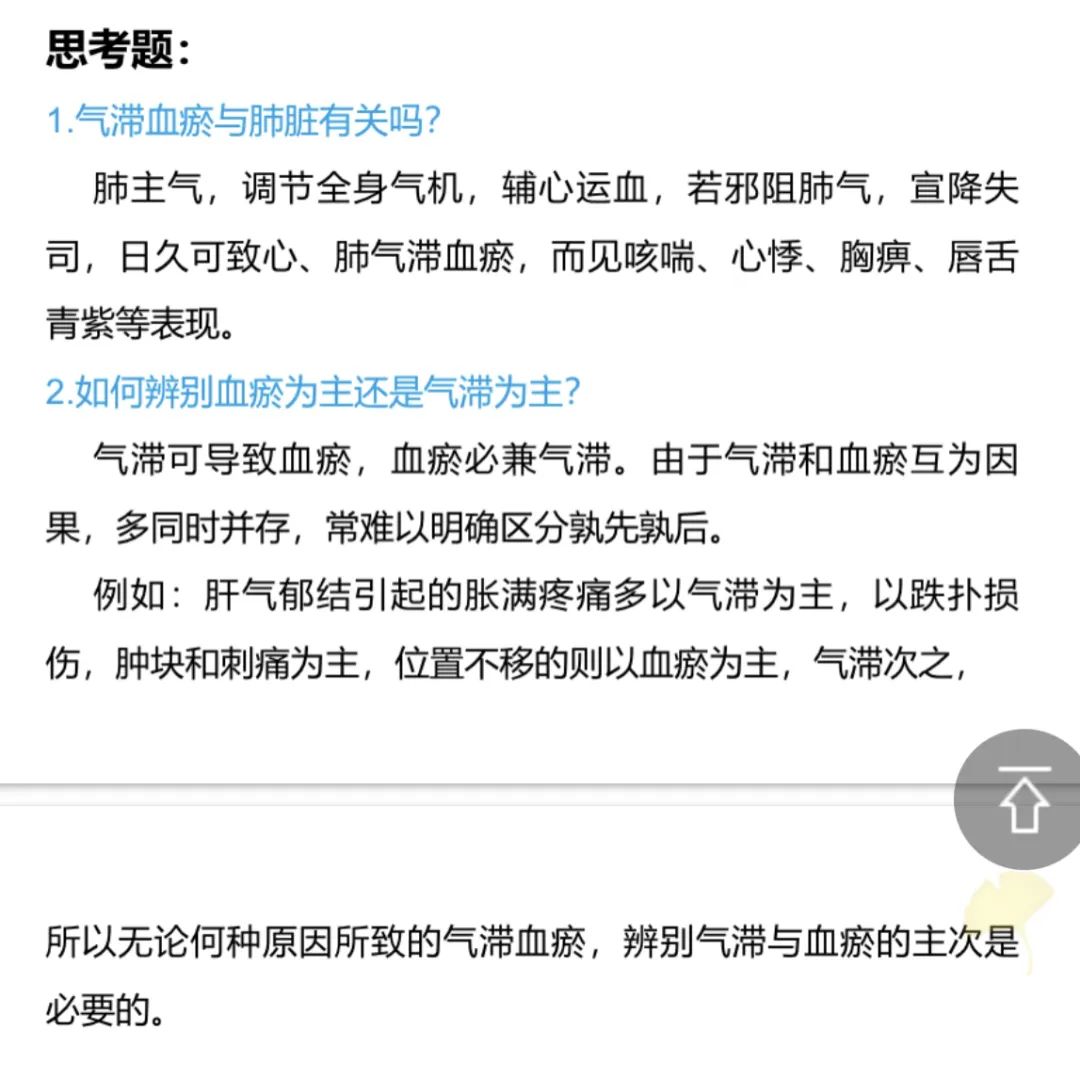[Syndrome Differentiation] Chapter Two: Syndrome Differentiation of Disease Nature
Section Five: Simultaneous Disease of Qi and Blood Lecture 35: Qi Stagnation and Blood Stasis Syndrome


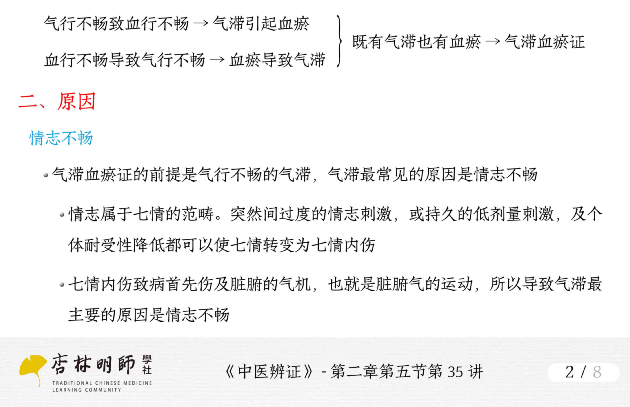
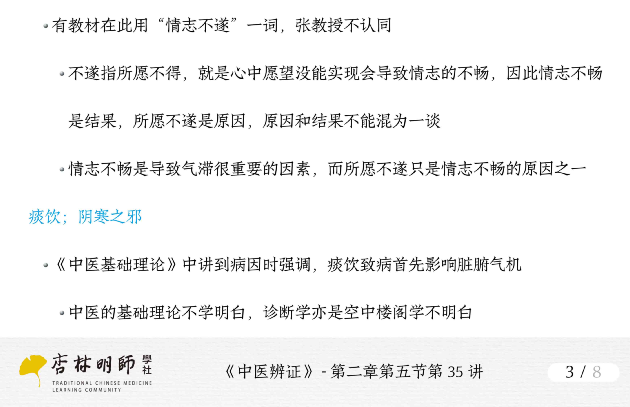


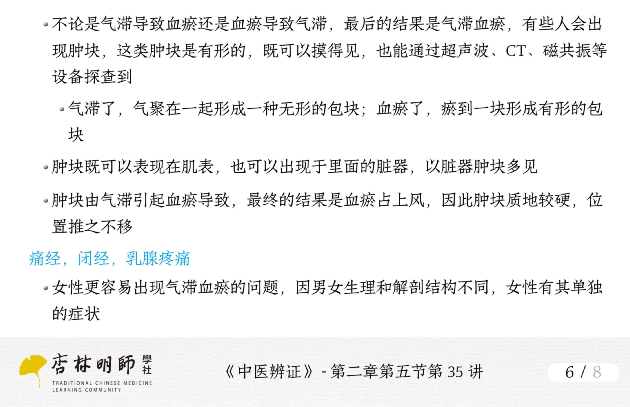

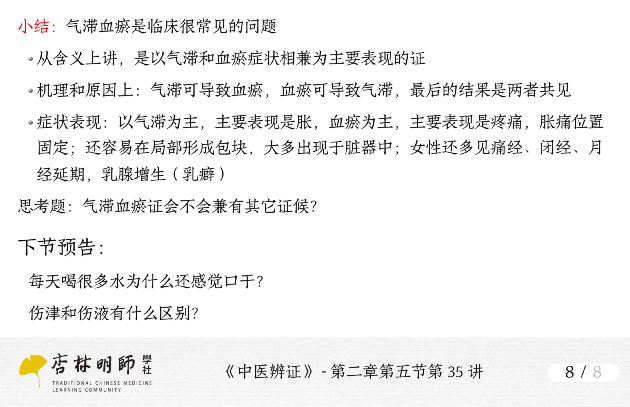
Question: What is Qi Stagnation and Blood Stasis syndrome?
Answer: It refers to a syndrome where both Qi stagnation and Blood stasis coexist. The obstruction of Qi flow leads to blood circulation disorders, resulting in a pathological state of blood stasis; conversely, blood stasis can further exacerbate Qi stagnation.
The liver governs the smooth flow of Qi and stores blood. The liver’s ability to regulate Qi plays a crucial role in the smooth flow of Qi, thus Qi stagnation and blood stasis are often closely related to the liver’s failure to regulate, where the obstruction of Qi flow leads to blood flow obstruction, and vice versa.
Question: What are the manifestations of Qi stagnation and blood stasis syndrome?
Answer: Common symptoms of Qi stagnation and blood stasis syndrome include chest and hypochondriac distension, stabbing or migrating pain, irritability, or emotional depression; localized masses that are painful, hard in texture, and immovable; or in women, menstrual irregularities, dysmenorrhea, dark purple menstrual blood with clots, or amenorrhea; breast pain.
Obstruction of Qi leads to distension and pain; blood stasis can form hard masses; emotional disturbances can lead to irritability and depression; blood stasis obstructing the vessels can cause dysmenorrhea, dark purple menstrual blood with clots, or even amenorrhea.
Question: How to differentiate Qi stagnation and blood stasis syndrome?
Answer: Differentiation is based on the pathogenesis and symptoms. Key points for differentiating Qi stagnation and blood stasis syndrome include:
(1) This syndrome is characterized by the obstruction of Qi and blood stasis as its pathogenesis.
(2) The presence of symptoms of both Qi stagnation and blood stasis serves as the basis for differentiation.
(3) There are often emotional triggers or accompanying emotional symptoms.
Question: What causes Qi stagnation and blood stasis syndrome?
Answer: (1) Emotional disturbances can first harm the organs’ Qi, affecting blood circulation.
(2) Phlegm and dampness, as well as cold pathogens, can obstruct Qi flow and hinder the movement of Qi and blood. Cold can cause contraction and stagnation, while cold pathogens obstruct Qi flow.
(3) Trauma can lead to blood stasis, which exacerbates Qi stagnation.
Qi stagnation and blood stasis influence each other, forming a vicious cycle.
Question: How to distinguish whether blood stasis or Qi stagnation is predominant?
Answer: Qi stagnation can lead to blood stasis, but blood stasis must also involve Qi stagnation. Since they are mutually causal and often coexist, it is often difficult to clearly distinguish which comes first.
For example, liver Qi stagnation causing predominant distension and pain is often primarily Qi stagnation, while trauma leading to hard, immovable masses is primarily blood stasis, with Qi stagnation as a secondary factor.
In simple terms, if distension is more pronounced, it is primarily Qi stagnation, while if pain is more pronounced, it is primarily blood stasis.
Question: What are the seven emotions? What are internal injuries caused by the seven emotions? What is the relationship between the two?
Answer: The seven emotions are joy, anger, worry, thought, sadness, fear, and shock, which are normal emotional changes.
Under certain conditions (when problems arise), these emotions can transform into pathogenic factors, known as internal injuries caused by the seven emotions. The terms used for both are the same.
Conditions for the transformation of the seven emotions into internal injuries:
First, sudden exposure to intense emotional stimuli that exceed the physiological and psychological tolerance of the body;
Second, small but persistent emotional stimuli that accumulate and exceed the physiological and psychological tolerance of the body;
Third, small emotional stimuli when the body’s organs and blood are deficient, leading to a low ability to adapt to emotional stimuli.
Question: What are the pathogenic characteristics of phlegm and dampness?
Answer: The characteristics of phlegm and dampness as pathogenic factors include:
(1) Obstructing Qi flow and affecting blood circulation. Once phlegm and dampness arise, they often obstruct Qi flow, hindering the movement of Qi and blood, which can lead to blood stasis over time, resulting in phlegm and blood obstruction.
(2) Affecting the organs’ Qi, exacerbating water metabolism disorders. Phlegm and dampness are pathological products of water metabolism disorders, but once formed, they can easily obstruct Qi flow, leading to abnormal rising and falling of the organs’ Qi, further affecting the distribution of fluids.
(3) Obscuring the orifices and disturbing the spirit. Internal phlegm can affect the heart and disturb the spirit, leading to a series of abnormal mental symptoms. For example, phlegm obstructing the clear orifices can cause dizziness, heaviness in the head, and mental fatigue.
(4) Widespread pathogenic effects and diverse transformations. Phlegm and dampness can affect any part of the body, and their pathological changes are varied, leading to complex clinical manifestations, hence the saying, “many strange diseases are due to phlegm.”
(5) Chronic and lingering disease course. Phlegm and dampness, being sticky in nature, often lead to prolonged and difficult-to-cure conditions. Common clinical manifestations such as dizziness, cough, asthma, chest obstruction, and epilepsy often recur.
Question: What diseases in women are most commonly associated with Qi stagnation and blood stasis syndrome?
Answer: In women, the liver is considered the source of their constitution, and they often suffer from liver-related diseases. The liver governs the smooth flow of Qi and can regulate women’s emotional states.
If the liver fails to perform its function, Qi stagnation occurs, leading to blood circulation issues, resulting in Qi stagnation and blood stasis syndrome, which can manifest as menstrual irregularities, delayed menstruation, amenorrhea, and dysmenorrhea. Breast hyperplasia in women is particularly closely related to liver stagnation.


